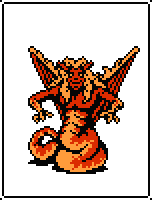Mitra, Mithra, or Mithras?
Names
The name Mithra specifically refers to the Zoroastrian yazata (a term of which the closest Judeo-Christian equivalent would be an angel) of the sun and oath, who has a separate personality and roles distinct from the Vedic Mitra who is a companion of Varuna in the ancient Indo-Iranian text the Rigveda, and from the Roman initiation cult deity Mithras whose worship still largely remains a mystery. However, as interpreted by series demon artist Kazuma Kaneko, this red-skinned, lion-headed, and snake-entwined figure has been called by all three names in various Shin Megami Tensei games and different regional versions.
 Mitra in Digital Devil Monogatari: Megami Tensei II. In Digital Devil Monogatari: Megami Tensei II, a slightly simplified version of this design appears as Mitra (ミトラ ). Instead of having the snake coiling around him, his very body is serpentine. Notably, Megami Tensei II is also the first Megaten title that Kazuma Kaneko provided designs for, suggesting a correlation to the modern appearance. This game has also never seen a release outside of Japan, so there is no official localization for this iteration.
Mitra in Digital Devil Monogatari: Megami Tensei II. In Digital Devil Monogatari: Megami Tensei II, a slightly simplified version of this design appears as Mitra (ミトラ ). Instead of having the snake coiling around him, his very body is serpentine. Notably, Megami Tensei II is also the first Megaten title that Kazuma Kaneko provided designs for, suggesting a correlation to the modern appearance. This game has also never seen a release outside of Japan, so there is no official localization for this iteration. Mithra in Majin Tensei II. The Japanese-exclusive release Majin Tensei II: Spiral Nemesis features the first appearance of Mithra (ミスラ) proper and has the only design that resembles the armored and adorned humanoid as he is depicted in classical Persian iconography. However, it is worth noting that Majin Tensei II has many designs not of Kaneko origin that have not been seen anywhere else in the series, this version of Mithra included.
Mithra in Majin Tensei II. The Japanese-exclusive release Majin Tensei II: Spiral Nemesis features the first appearance of Mithra (ミスラ) proper and has the only design that resembles the armored and adorned humanoid as he is depicted in classical Persian iconography. However, it is worth noting that Majin Tensei II has many designs not of Kaneko origin that have not been seen anywhere else in the series, this version of Mithra included. Mitra/Mithra's current form as seen in Shin Megami Tensei: Imagine. In the Japanese version of Shin Megami Tensei: Nocturne, where this current leontocephaline (see below) design by Kaneko first appeared, and subsequently in Shin Megami Tensei: Persona 3, Shin Megami Tensei: Persona 4, and Shin Megami Tensei: Imagine, this design is again referred to as Mitra. However, in the English localizations of all four of those games, he is called Mithra.
Mitra/Mithra's current form as seen in Shin Megami Tensei: Imagine. In the Japanese version of Shin Megami Tensei: Nocturne, where this current leontocephaline (see below) design by Kaneko first appeared, and subsequently in Shin Megami Tensei: Persona 3, Shin Megami Tensei: Persona 4, and Shin Megami Tensei: Imagine, this design is again referred to as Mitra. However, in the English localizations of all four of those games, he is called Mithra.- In the Japanese version of Shin Megami Tensei: Strange Journey, he is called Mithra (ミスラ). To add another twist to the knot, in the English version of Strange Journey this same demon is called Mithras. (Further adding to the confusion, the actual Roman cult deity Mithras is in Strange Journey, with his name misinterpreted as Mitra in English; in the Japanese version he is correctly identified as Mithras [ミトラス].)
As of the release of Shin Megami Tensei IV, the names of the Roman Mithras and the leontocephaline design (as Mithra) have achieved parity across regions.
Images of Mithra and the Leontocephaline
 A leontocephaline currently in the possession of the Vatican library.
A leontocephaline currently in the possession of the Vatican library.Mithra's design in the Shin Megami Tensei series is clearly modeled after the leontocephaline, a type of statue of a man with a lion's head holding a key or scepter as a snake coils up around his body. Leontocephalines have been found and are associated with the secret temples devoted to Mithras found in the Roman world. However, these images do not represent Mithras himself; while scholars are still unsure of the leontocephaline's exact identity, inscriptions may link it to representing the Zoroastrian antagonist Ahriman or other figures entirely, such as the Gnostic god Yaldabaoth, who is said to have been born with the head of a lion and the body of a snake. The idea of Mithra being represented by the leontocephaline is in contrast to Zoroastrian art, where he is depicted as a human-like figure, with a pointed Phrygian cap, long robes, and more often than not with rays of light emanating forth from him, representing his relation with the sun.
 Sraosha's design from the Devil Summoner series. His features are more mineral than animal.
Sraosha's design from the Devil Summoner series. His features are more mineral than animal.Also, beginning with their designs in the 32-bit era, Kazuma Kaneko gave Mithra's fellow yazatas Armaiti and Sraosha a visual design similitude, with sleek and shimmering winged bodies seemingly split and hollow, devoid of facial features except for strange orbs within the divide in their heads and elsewhere. The leontocephaline-inspired design for Mithra does not share any of their unique attributes and this with other signs may point to the fact that in Shin Megami Tensei, this lion-faced god was most likely intended to be the Vedic deity Mitra.
Log in to comment